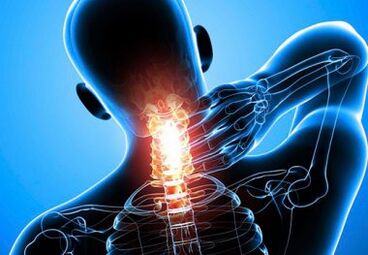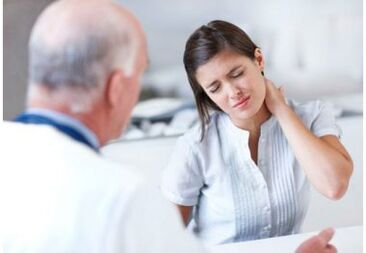Symptoms of cervical osteochondrosis are manifestations of dystrophic changes in cartilage tissue and intervertebral discs. The development of pathology contributes to the collapse and deformation of the vertebrae. As a result, the patient experiences pain, dizziness and nausea.

Osteochondrosis of the cervical spine is accompanied by persistent or recurrent neck pain. This is the main symptom of cervical osteochondrosis.
The first symptoms
The cervical spine contains the main blood vessels that nourish the brain. Micro-impulses from the main organ and the central nervous system pass through the nerve fibers. The severity of symptoms depends on the degree of the disease and individual characteristics. With cervical osteochondrosis, the discs that perform the function of cushioning have a negative effect:
- The structure is changing.
- The growths in osteochondrosis are small due to the growth of bone tissue. As a result, the blood supply deteriorates and nerve fibers are damaged.
The first symptoms of the disease are not expressed.

With the further development of osteochondrosis of the neck, severe pain is observed, which is the main symptom. Anxiety increases during exercise, muscle tension develops.
Different categories of people are at risk. The process is determined by the factors that lead to the development of cervical osteochondrosis:
- sedentary lifestyle;
- excess weight;
- accompanying pathologies - scoliosis, rheumatism;
- excessive physical activity;
- spinal cord injury.
The main symptoms in the later stages of the development of osteochondrosis of the neck
Changes in cartilage tissue manifest themselves in the form of symptoms, the severity of which depends on the severity of dystrophic diseases. Processes can cause disruption of any internal system of the body:
- Compression of nerve endings is characterized by symptoms in the form of osteochondrosis neuralgia. Neurological diseases can occur when the spinal cord is compressed. Bone growths in the nerve roots partially or completely immobilize the vertebrae, leading to their fusion. Loss of sensitivity is observed.
- Compression of the main and peripheral blood vessels leads to insufficient blood circulation. Oxygen starvation occurs, heart function deteriorates. Symptoms of cervical osteochondrosis: frequent migraines, increased blood pressure, loss of coordination, vascular dystonia, respiratory dysfunction. There may be problems with hearing and vision.
External manifestations of cervical osteochondrosis
External symptoms are characterized by extensive damage to the body. Patients do not complain of deterioration of general well-being in the pathology of the first stage. To prevent the onset of the disease, it is recommended that you lead an active lifestyle, go swimming and do health-improving gymnastics.

The sensation in cervical osteochondrosis of the second phase is characterized by pain syndrome, which leads to stiffness of movements.
Anxiety can be localized in different parts of the spine. Patient performance decreases. Vascular constriction causes general weakness and migraine. Head tilt and rotation increase anxiety in osteochondrosis.
The third stage of the disease is characterized by more pronounced symptoms: sharp pain on palpation of the pathological area, inactivity, movements are characterized by wheezing, dizziness, nausea. The condition manifests itself with loss of consciousness, the patient feels a lump in the throat. Circulatory disorders cause fluctuations in blood pressure and hypertension. Convergence of the upper extremities occurs.
The fourth stage is determined by the deterioration of the situation. With an advanced form of cervical osteochondrosis, the patient may develop a disability. The main symptom is immobilization of the cervical vertebrae. Compression of arteries and nerve fibers reaches a maximum, which manifests itself in the form of tinnitus, visual disturbances, hearing. There is a speech disorder - numbness of the tongue, loss of coordination.
Treatment of localized osteochondrosis in the neck is carried out using a conservative therapy using drugs.
The doctor prescribes physiotherapy, health-improving gymnastics. In case of exacerbation of the pathology, it is recommended to undergo a course of rehabilitation massage to eliminate the pain syndrome.
Internal symptoms and manifestations of osteochondrosis of the cervical spine
Internal symptoms characterize changes in the structure of cartilage tissue in osteochondrosis:
- Stage I of chondrosis. The physiological structure of the chain is disturbed. Due to lack of fluid, the space between the vertebrae narrows. Muscle hypertension occurs.
- Stage II of cervical osteochondrosis is characterized by thinning of the intervertebral discs, which reduces the height, which increases the load on the musculoskeletal system. The result is pain.
- Phase III. Cartilage deformity occurs, bone tissue proliferation is observed, intervertebral hernia is formed, protrusion occurs. Disc dropouts were recorded. The symptoms of the condition are characterized by severity. Osteoarthritis begins to develop.
- Stage IV. Complete destruction of the discs between the vertebrae by further replacement of the cavities with bone or connective tissue. The process causes aggregation to occur.

To prevent the development of the disease, it is recommended to regularly exercise at home to strengthen the muscle corset with osteochondrosis. Special medications, ointments and injections are prescribed to relieve the pain. Folk remedies are used in the form of compresses, dressings.
Are the symptoms different between men and women?
The neck is the most mobile part of the musculoskeletal system, with 7 vertebrae. The division begins with the pectoralis and attaches to the skull. Symptoms of cervical osteochondrosis in women do not differ from the pathological manifestations in men. According to statistics, women are more prone to the onset of the disease due to the anatomical structure, possible pregnancy.
The course of the disease depends on the accompanying conditions, hormonal levels, symptoms and other factors.
| Differences | Men | Women |
| Section of the spine | Larger size. | Small. |
| System functions | The body is under constant stress. Fractures are less common due to more developed muscles. | Adapts better to loadsOsteochondrosis, curvature in the form of scoliosis, osteoporosis are often diagnosed. |
| Clinical picture | The situation is characterized by stability. Low pain threshold. Patients are not able to clearly describe all the symptoms. | Symptoms are announced. Patients clearly express their complaints. |
| Age changes | The body does not undergo reconstruction of internal systems for 45-50 years. | Changes as a result of pregnancy, hormonal changes are observed after 45 years. There may be pain, numbness in the hands. |
Fetal delivery may be accompanied by the appearance of symptoms:
- development of cervical, lumbar osteochondrosis;
- compression of nerve endings;
- occurrence of problems with the cardiovascular system;
- stiffness of movement.
Make sure you watch part of a popular health show. This number lists in detail all the main symptoms of cervical osteochondrosis:
Diagnosis of cervical spine osteochondrosis
Comprehensive diagnosis of osteochondrosis of the neck, taking into account the severity of the disease and its symptoms, is the key to a favorable course of the condition. Different methods are used to make a correct diagnosis:
- Examination. After consulting a doctor, a visual assessment is performed using the parameter - gait, posture. A complete history of the patient's symptoms is taken.
- Radiography is a convenient examination method. It is characterized by the possible occurrence of outcomes that affect the overall well-being of the patient. A snapshot of the cervical spine is taken from the base of the skull to the upper chest. The study shows the condition of the intervertebral discs.
- Tomography. There are two types: computerized and magnetic resonance imaging (MRI). In the first case, with the help of a special device, a specialist prepares slices under the influence of X-rays. The resulting image is displayed on a computer screen, the 3D model is executed. The second type of examination is based on the work of electromagnetic waves. Layers of a certain part of the body are taken.

If the symptoms of osteochondrosis in the neck are characterized by intense development, you should consult a doctor.
Prevention of osteochondrosis of the neck
To prevent the disease, it is recommended to lead an active lifestyle, exercise regularly and swim. With an advanced pathological form, a course of treatment is prescribed, including the administration of drugs that relieve pain and normalize the functioning of the body's internal systems.






















